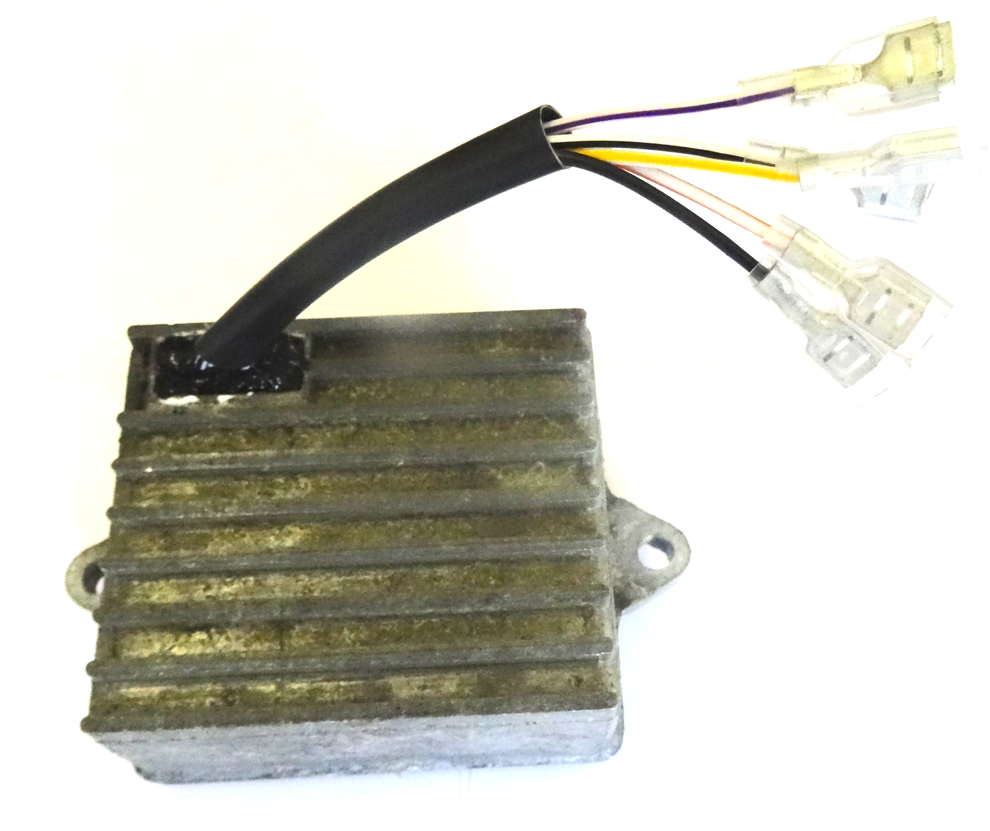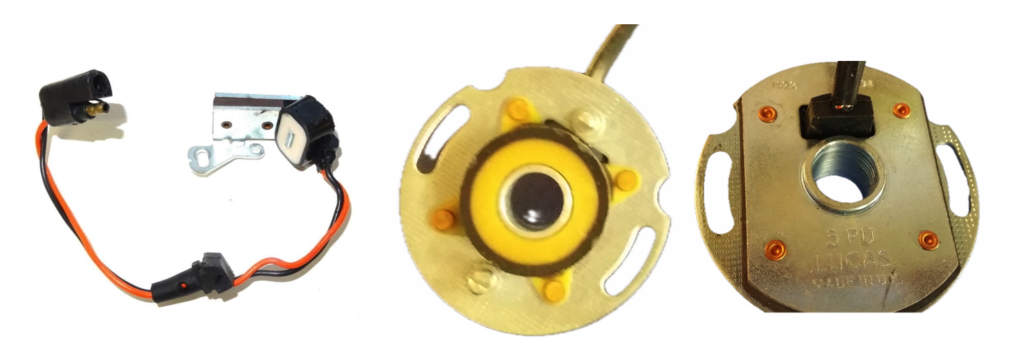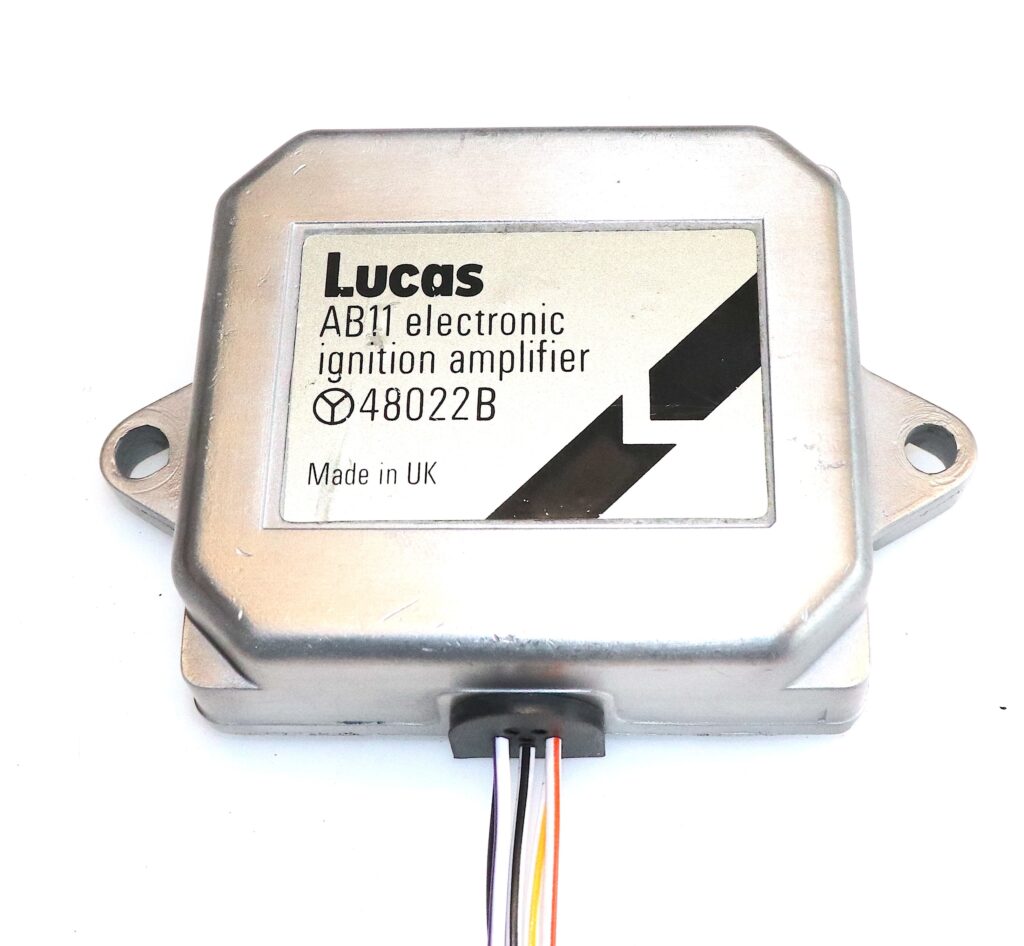AB11 Unit
The Lucas Rita electronic ignition system was and remains an extremely solid electronic motorcycle ignition that came to popularity in the 1970’s and 80s and was still for sale in the 1990’s. When the RITA was first introduced points ignition dominated the market and retro-fit electronic ignitions for motorcycles were few and far between. The Rita had a build quality that was far superior to typical aftermarket systems, as you would expect coming from a large manufacturer. However even the casual observer can’t fail to notice that the fitting guides aren’t on Lucas headed paper, nor are there many Lucas publications on the system. The factory published manuals for everything except the RITA ignition its seems.
In fact the RITA was intended for the car market but the system was not taken up by manufacturers who instead chose to use the cheaper and more technically advanced system from General Motors that was available at the time. Lucas had also developed a pick-up unit designed to go inside a typical car distributor but as the system was not taken up by mainstream manufacturers production of this pick-up stopped.
It was a company called Mistral Engineering in the UK who manufactured cigarette vending machines that first bought AB5 units (and later the AB11 units) from Lucas Industries and manufactured a series of pressed parts, spun aluminium covers and various hardware to allow the RITA to be fitted to motorcycles. Mistral Engineering suddenly had to find a commercially available solution for the pick-up which Lucas no longer supplied, this is the most likely explanation as to why early versions had a Lucas pick-up but the later kits supplied by Mistral used an entirely different, non Lucas part referred to as the “C” type pick-up.
Lucas dusted off the 5PU pick-up and either made a batch or more likely discovered a box of them in a store room for the very last Triumph T140E models. The 5PU can swapped for a “C” type, if you have all the parts to do it, both work exactly the same with the RITA unit. All in all the solid cast alloy box and robust electronics of the RITA suits motorcycle use very well.
A Bistable Amplifier?
The Amplifier part is obvious, it makes a small signal in to a larger one, in this case a tiny pulse from the pick-up into a signal large enough to cause the HT coil to spark at the plug. The Bistable part means nothing more than a circuit that remains in whatever state you select it to, IE ON or OFF. Just as the cam acts on the heel of the points, the contacts are open or closed and remain so until the cam position is moved, this is what bistable refers to. An issue with the RITA is that when the ignition is on it allows current to flow to the coils if the engine is started or not. This is the same situation when a set of points are closed and the ignition is ‘on’ also. Modern electronic ignitions switch off the coil power when the engine stops turning, even if the ignition is left ‘on’.
Electronic Advance Curve
Mechanical advance mechanisms were made as accurate as possible, but they quickly lose this accuracy in use and none came even close to the accuracy achieved by electronics. A combination of an increasing in signal strength from the pick-up as the engine speeds up and clever set up of the amplifier section gives dependable and repeatable performance that is not subject to mechanical variation and remains highly accurate in all conditions.
The most difficult faults to solve with the RITA (or any ignition for that matter) happen when the electronic boxes become old. The carefully set up electrical ‘tuning’ of the amplifier can drift or fail altogether as components dry out or begin to work less well. The advance may still function after a fashion but an aged component can change the system’s characteristics often causing random misfiring or generally off colour running. Chasing such faults on a circuit board is very time consuming and you can quickly run up a labour bill far in excess of the cost of a new ignition. We came up with the idea of a simple ‘change out’ or ‘Revival’ circuit board to give a repair option that replaces all the old electronics with a far lower price tag.
The design of the RITA is perhaps in some ways a little too simple, especially in today’s world, but on a motorcycle a simple, robust system is rarely a bad thing.

AB5 Unit
AB5 Versus AB11
There exists two versions of the RITA; The AB5 – (48016) and AB11 – (48022). These represent natural product development, the AB11 improved upon and replaced the AB5. With the exception of units made for BMW models and a few ‘special race’ versions, all versions function the same electronically and are interchangeable. Our ‘Revival’ replacement for the RITA uses less current than the AB11, it also gives more protection against reversed connections but to maintain full compatibility and by necessity it functions exactly the same as a Lucas RITA circuit. It is intended as a repair option that is fully compatible with historical systems.
AB5
Transistors are current operated devices, IE to make them work like contact breakers and switch on and off they require a current proportional to the current they are switching. Early transistors were inefficient and needed a great deal of current, this is why the AB5 has a large resistor on the outside of the case as it uses a relatively large current to operate the amplifier (in addition to the current used by the HT coil.) The AB5 is the larger unit and has a finned case.
AB11
This is the later version and has a much more efficient amplifier using significantly less current than the AB5. The case is also less bulky and has a nice smooth appearance, in fact they polish up very well.
As a side note, the latest version of our “Revival” circuit only requires a few milliamps to run the amplifier circuit, significantly less than the AB11.

RITA Power resistors: The same component is shown removed from the different RITA versions and compared with the ‘Revival’ component. The power hungry AB5 needs a very large finned 10 watt resistor due to the power needed to operate the amplifier. The AB11 amplifier is more efficient so uses a smaller 5 watt internal resistor. Our revival circuit uses a 0.75W chip resistor.
Coloured Case Panels
These identify different applications for the RITA unit, the yellow panel is the commonly found version.
Blue – This version has since been incorporated in to all the designs as the ignition unit must function despite a lot of ‘noise’ in a motorcycle’s electrical system. Car alternators cause less interference than permanent magnet motorcycle alternators, hence this feature was likely not foreseen in the original designs. It was Police motorcycles that highlighted the issue as they were fitted with larger alternators to power extra lights and a radio set. As alternators became larger so did the electrical interference they create. Resistor plug caps are also needed to avoid similar problems.
Yellow – The most common and used extensively for many different applications.
Green – Very rarely seen and was for BMW R90S, RS100, S100 and all suitable BMW models of that era.
Black – For certain Norton race applications. We have never seen one, but have heard they shorted out the electronic advance to reduce timing advance for racing application. Certainly some units we have seen had a jumper wire inside them that does exactly this.
Reluctor Types
The reluctor is the solid steel part that rotates, its shape works with the pick-up to produce some of the timing information. There are advancing and non advancing types for two stroke applications. The Lucas 5PU pick-up is magnetically reversed compared to all other systems in use today, hence the reluctor was larger and ‘opposite’ in shape to the others.

Left to right: GT750 non advancing 2-stroke reluctor. Honda 400/4. Moto Guzzi. Right Lucas 5-PU reluctor which has an accentuated profile as the magnetic polarity is reversed in the pickup compared to modern designs.
Pick-up types
Although four types are mentioned in historical documents only two are commonly found in use. The 2PU is rare and at the time of writing we have only ever seen one. The ‘C’ type is the most common and can be swapped with the 5PU, which we believe was the one designed specifically for the RITA. Generally the pick-up is very reliable however they are very old now and it is well known that as windings age their insulation becomes weaker which can cause many different issues due to the random way the insulation breaks down before failing completely.
C and a ‘low’ C type approx 200-450 ohms. These must measure 270Ω at 20 degrees C.
2 PU type approx 1500 – 2000 ohms.
5 PU type approx 600 – 700 ohms
The ‘C’ type is adjustable for clearance with the reluctor. The clearance is 0.2-0.3mm (0.008 – 0.012”). If the gap is larger there will be running issues or the engine may fail to start at all.
We stock new ‘C’ type pickups (when available).

The ‘C’ type (left) and the 5PU (top and lower view)
Running without a battery
It is possible to operate without a battery, provided you fit a capacitor or ‘battery eliminator’. We have two options for battery eliminators but draw your attention to the disadvantages. Running without a battery is extremely crude and leaves you without any lights at night if the engine stalls. This is extremely dangerous if you are on the road as you may not been seen by other road users. Additionally indicators and horns don’t work well and the headlamp will have a tendency to flicker at idle without a battery. Above 2,500 RPM everything should work normally however. Electric starters will not work without a battery!
Connectors
The RITA ignitions made after 1976 had a lead 150mm long and a ‘560′ series 5 way connector fitted. This was a ‘Rists’ connector and these are available today (Google ‘Rists Connectors’). These are OEM connectors and come with an OEM equipment price tag. A far cheaper option are the Japanese style connectors that are mass produced, we have these in stock at a lower cost.
Operating Voltage
The Rita will operate reliably from 14 down to 9 volts (information from a factory letter on the subject). It should be noted the Lucas zener diode was a crude method of voltage control that caused large surges in power as it regulates and often allowed the voltage to get as high as 15.8 volts.
Cars have a very controlled charging system and large batteries that give a very steady voltage compared to motorcycles equipped with zener diodes. If a good battery of the correct size and a modern voltage regulator are used (a good analogue type it doesn’t have to be a MOSFET) this avoids any problems. If you are having ‘poor running at speed’ issues and have a zener diode fitted, replace it for a modern regulator rectifier to see if this helps. We have suitable units available.
Rev Counters
Any rev counter fitted must be able to use a 12 volt signal from the switched side of the HT coil (that is the side connected to the RITA unit) where the reluctor runs at half engine speed and the engine has one or two cylinders. There are many cheap electronic rev counters available today that may allow different configurations. Before purchasing please make sure it comes with clear instructors as what input it uses and how to connect it.
Multicylinder Engines
The RITA is a ‘single channel’ unit IE it has one transistor to drive the HT coil. You can think of this as one set of contact breakers. Running one or even two HT coils connected in series works well, you can see this with contact breakers too. It is not clear where the idea to connect three HT coils originated, undoubtedly it works, but it is one that devoid of safety margins and drives a single transistor to the absolute limit. A two transistor unit driving a pair of dual HT coils (or a dual and a single HT coil for triples) would have been much better and meet modern design standards. Such a system is found on some Hinckley triples that use two separate HT coils.
Finally
We would like to thank Mr Alan Osborn, who has looked after the RITA for many years but has now sold the remaining Mistral Engineering stock to us. This comprises the mounting kits, general parts and covers they manufactured, an extremely useful source of reference.
Our plan is to continue to offer a repair service for the RITA and to support the historical systems still in use. Any new system could only draw on what made the RITA so reliable but would have to leave the 1970’s electronics design in the history books. Modern standards would be used and allowance for electric starts that cause the voltage to drop at start up built in. Multi cylinder operation would require a more solid ‘two channel’ unit.
Apologises if this article is found to contain inaccuracies or we we have ommitted to mention something. Much of the historical story was antidotal and spoken from memory by those old enough to remember when Mistral was producing these kits. Where possible we have refered to printed factory documents for technical accuracy.
Lucas is a registered trade mark. We are not affiliated with the Lucas brand.

